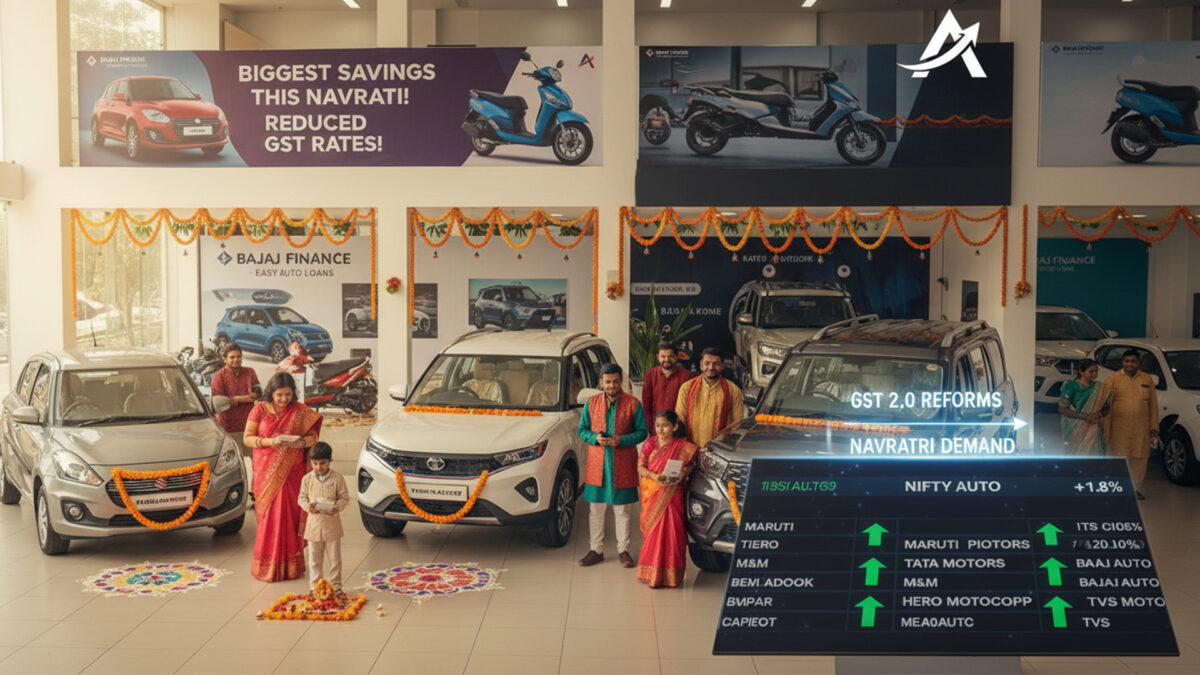Strong signs of demand in both the two‑wheeler and four‑wheeler segments have lifted shares of automotive companies, with the Nifty Auto index gaining nearly 1.8 percent on September 23. Trimmed by weakness elsewhere in the market, the auto rally was led by names like Maruti, Tata Motors, Mahindra & Mahindra, Hero MotoCorp, Eicher, along with Ashok Leyland, Bajaj Auto, TVS Motor, and Bharat Forge. The popular NBFC Bajaj Finance also got buoyed as auto financing looks set to gain from the surge in vehicle purchases.
Channel checks and early festive‑season data indicate that the first day of Navratri has seen healthy customer activity. Maruti reported close to 30,000 bookings and around 80,000 enquiries on Day 1, while enquiries for small cars have surged nearly 50 percent over normal levels. Hyundai Motor India recorded around 11,000 dealer billings on September 22, marking its best single‑day performance in the past five years. Analysts believe that the combination of reduced GST rates (under GST 2.0 reforms), festival sentiment, and better price affordability have unlocked pent‑up demand that was held back during the Shraddh period.
Brokerages have turned quite optimistic. Goldman Sachs upgraded Maruti Suzuki’s rating from Neutral to Buy, setting a target price of Rs 18,900 per share. The upgrade helped push Maruti shares to a 52‑week high. Other firms, such as Nuvama, expect the demand upcycle for passenger vehicles (PVs) to continue through FY29, supported by favorable tax policies, upcoming government pay‑commission recommendations, new model launches, and expectations of further rate cuts by the RBI. Experts at Nuvama note that historically the upcycle in autos lasts about six to eight years, suggesting there is room for the current momentum to extend further.
Despite the positives, some challenges persist. Supply constraints for certain popular variants could test the ability of manufacturers to meet demand. Price sagas in electric two‑wheelers have narrowed, yet consumers are showing willingness to pay more for differentiated or premium features. Heavy vehicles are seeing stronger value growth rather than volume growth, as fleet operators prefer shifting to higher tonnage trucks to improve margins and utilization.
From a policy perspective, the recent GST reforms (GST 2.0) appear to be delivering early results. The downward reconstructions in tax rates on passenger vehicles and two‑wheelers have made entry‑level models more affordable. Analysts suggest these reforms may be key in sustaining demand through the festival season and beyond.
Looking forward, industry experts believe that if domestic demand remains strong, OEMs that manage costs effectively and maintain supply will benefit most. Dealers anticipate volume growth of over 20 percent during the core festive period from October to December. Auto companies are adjusting strategy to ensure small car and affordable EV segments are well stocked, as growth in those areas could define winners in the near term.
Also Read: Government refuses to extend Vedanta’s contract for Cambay basin oil & gas block
